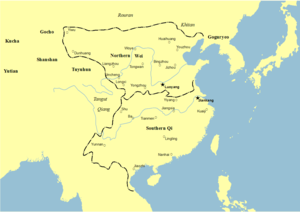The Southern Qi Dynasty ( Chinese Ex. 齊 朝 , Pinyin : Qí cháo )) is the second among the Southern Dynasties in China , which was replaced by the Liang Dynasty . Existed in 479 - 502 years . In the course of its 23-year history, the dynasty constantly faced with instability. In fact, the country has four emperors and three short-term minor rulers who were quickly removed and killed by their patrons to free the throne. [1] [2]
| Historical State | |
| South Qi | |
|---|---|
- | |
| Capital | |

Capital - The capital was the city of Jiangkang , located on the territory of modern Nanking .
As after the death of the able emperor Gao-di , and then the emperor W-di , when the grandson of the emperor W-di Yulin-wang was killed by a clever but cruel and suspicious relative of W-di, Xiao Luan , who took the title of emperor Ming-di and arranged mass executions of the sons and grandsons of the emperors Gao-di and W-di, as well as many officials whom he suspected of conspiring against him. The arbitrariness with which these executions were carried out, has intensified with the coming to power of the son of Ming-di, Dunhun-hou , whose actions provoked numerous uprisings. The last of them, led by the commander Xiao Yan , led to the fall of South Qi and the coming to power of the Liang dynasty. Xiao Yan occupied the throne, proclaiming himself the emperor Wu di new dynasty. [3]
The emperors of the Southern Qi dynasty waged frequent wars with northern China - the Northern Wei dynasty, which went on with varying success. The riots represented a great danger, which became especially frequent during the last emperors. At dawn of the dynasty, the rebellious general surrendered to the northerner the important Shouyan region, which the southern dynasty of Liang later won back many years. . [4] [5] . [6]
Emperors of Southern Qi
| Posthumous name | Personal name | Years of government | Board motto (правления niánhào) and years |
|---|---|---|---|
| Historically the most commonly used form: Qi + posthumous name | |||
| Gao di 高帝 Gāodì | Xiao Daocheng 蕭道成 Xiāo Dàochéng | 479 - 482 |
|
| Wu di 武帝 Wǔdì | Xiao Tse 蕭 賾 Xiāo Zé | 483 - 493 |
|
| Yulin-wang 鬱林 王 Yùlínwáng | Xiao Zhao 蕭 昭 業 Xiāo Zhāoyè | 494 |
|
| Hailin-van 海陵 王 Hǎilíngwáng | Xiao Zhaowen 蕭昭文 Xiāo Zhāowén | 494 |
|
| Min-di 明帝 Míngdì | Xiao Luan 蕭 鸞 Xiāo Luán | 494 - 498 |
|
| Donhun hou 侯 Dōnghūnhóu | Xiao Baojuan 蕭 寶 卷 Xiāo Bǎojuǎn | 499 - 501 |
|
| Hee di 和帝 Hédì | Xiao Baozhun 蕭 寶 融 Xiāo Bǎoróng | 501 - 502 |
|
Notes
- 、 川 本 『国 、 、 大 大 大 大 大 大 大 大 大 大 大 大 大 大 大 大 大 大 大 大 1 1
- 15 川 本 『国 国 大 大 大 大 大 大 大 大 15 15 15 15 15 15 15 P152
- 、 川 本 『国 国 、 大 大 大 大 大 大 大 15 15 15 15 15 15 15 P153
- ↑ Tang, Qiaomei (May 2016). (PhD ) (PDF) for the dissertation of the Philosophy in the United States of America. of East Asian Languages and Civilizations). Cambridge, Massachusetts: Harvard University. pp. 151, 152, 153.
- ↑ China: Dawn of a Golden Age, 200-750 AD . - Metropolitan Museum of Art, 2004. - P. 30–. - ISBN 978-1-58839-126-1 .
- ↑ Ancient and Early Medieval Chinese Literature (vol.3 & 4): A Reference Guide, Part Three & Four . - BRILL, September 22, 2014. - P. 1566–. - ISBN 978-90-04-27185-2 .